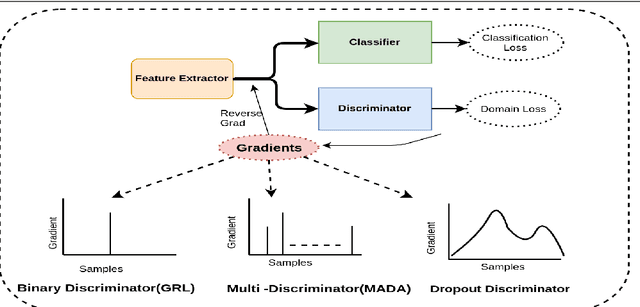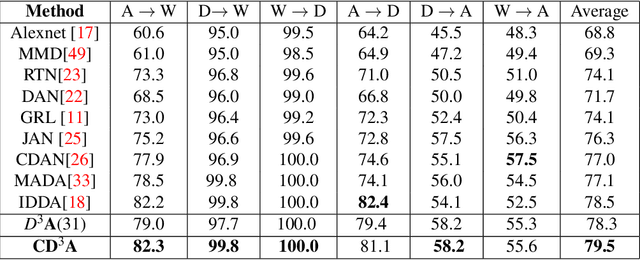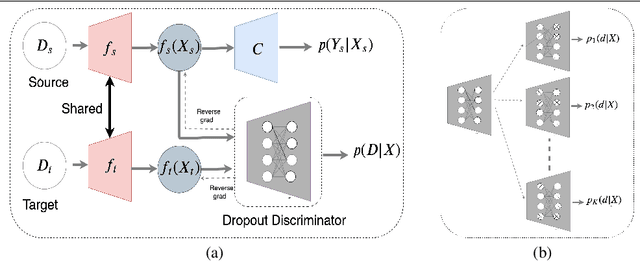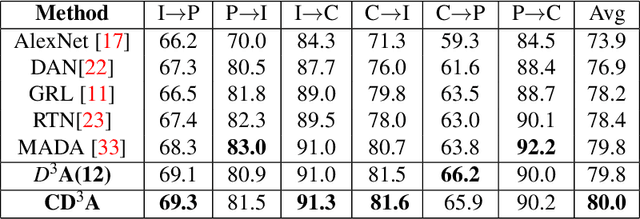Vinod Kumar Kurmi
Mitigating Uncertainty of Classifier for Unsupervised Domain Adaptation
Jul 01, 2021



Abstract:Understanding unsupervised domain adaptation has been an important task that has been well explored. However, the wide variety of methods have not analyzed the role of a classifier's performance in detail. In this paper, we thoroughly examine the role of a classifier in terms of matching source and target distributions. We specifically investigate the classifier ability by matching a) the distribution of features, b) probabilistic uncertainty for samples and c) certainty activation mappings. Our analysis suggests that using these three distributions does result in a consistently improved performance on all the datasets. Our work thus extends present knowledge on the role of the various distributions obtained from the classifier towards solving unsupervised domain adaptation.
Curriculum based Dropout Discriminator for Domain Adaptation
Jul 24, 2019



Abstract:Domain adaptation is essential to enable wide usage of deep learning based networks trained using large labeled datasets. Adversarial learning based techniques have shown their utility towards solving this problem using a discriminator that ensures source and target distributions are close. However, here we suggest that rather than using a point estimate, it would be useful if a distribution based discriminator could be used to bridge this gap. This could be achieved using multiple classifiers or using traditional ensemble methods. In contrast, we suggest that a Monte Carlo dropout based ensemble discriminator could suffice to obtain the distribution based discriminator. Specifically, we propose a curriculum based dropout discriminator that gradually increases the variance of the sample based distribution and the corresponding reverse gradients are used to align the source and target feature representations. The detailed results and thorough ablation analysis show that our model outperforms state-of-the-art results.
Attending to Discriminative Certainty for Domain Adaptation
Jun 08, 2019



Abstract:In this paper, we aim to solve for unsupervised domain adaptation of classifiers where we have access to label information for the source domain while these are not available for a target domain. While various methods have been proposed for solving these including adversarial discriminator based methods, most approaches have focused on the entire image based domain adaptation. In an image, there would be regions that can be adapted better, for instance, the foreground object may be similar in nature. To obtain such regions, we propose methods that consider the probabilistic certainty estimate of various regions and specify focus on these during classification for adaptation. We observe that just by incorporating the probabilistic certainty of the discriminator while training the classifier, we are able to obtain state of the art results on various datasets as compared against all the recent methods. We provide a thorough empirical analysis of the method by providing ablation analysis, statistical significance test, and visualization of the attention maps and t-SNE embeddings. These evaluations convincingly demonstrate the effectiveness of the proposed approach.
Looking back at Labels: A Class based Domain Adaptation Technique
Apr 02, 2019



Abstract:In this paper, we solve the problem of adapting classifiers across domains. We consider the problem of domain adaptation for multi-class classification where we are provided a labeled set of examples in a source dataset and we are provided a target dataset with no supervision. In this setting, we propose an adversarial discriminator based approach. While the approach based on adversarial discriminator has been previously proposed; in this paper, we present an informed adversarial discriminator. Our observation relies on the analysis that shows that if the discriminator has access to all the information available including the class structure present in the source dataset, then it can guide the transformation of features of the target set of classes to a more structure adapted space. Using this formulation, we obtain state-of-the-art results for the standard evaluation on benchmark datasets. We further provide detailed analysis which shows that using all the labeled information results in an improved domain adaptation.
 Add to Chrome
Add to Chrome Add to Firefox
Add to Firefox Add to Edge
Add to Edge